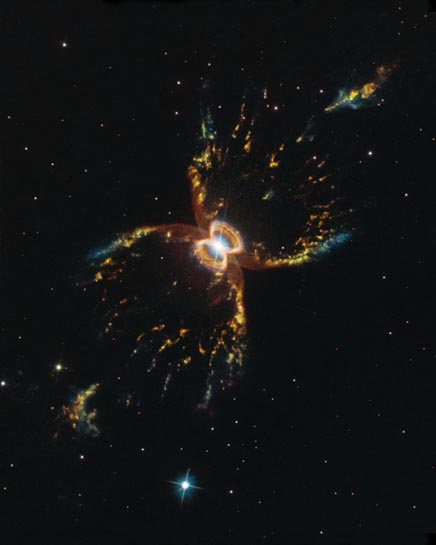
Nebula
RA 14h 11m 52.09s Dec -51° 26' 24.39"
Centaurus
10,700 light-years
14.2
Image is 1.4 arcmin across (about 4.4 light-years).
March 11-14, 2019
1.39 x 1.62 arcminutes
North is 16.3° left of vertical
NASA, ESA, and STScI
April 18, 2019
ABOUT THIS IMAGE:
This incredible image of the hourglass-shaped Southern Crab Nebula [1] was taken to mark the NASA/ESA Hubble Space Telescope's 29th anniversary in space. The nebula, created by a binary star system, is one of the many objects that Hubble has demystified throughout its productive life. This new image adds to our understanding of the nebula and demonstrates the telescope's continued capabilities.
This peculiar nebula, which exhibits nested hourglass-shaped structures, has been created by the interaction between a pair of stars at its center. The unequal pair consists of a red giant and a white dwarf. The red giant is shedding its outer layers in the last phase of its life before it too lives out its final years as a white dwarf. Some of the red giant's ejected material is attracted by the gravity of its companion.
When enough of this cast-off material is pulled onto the white dwarf, it too ejects the material outwards in an eruption, creating the structures we see in the nebula. Eventually, the red giant will finish throwing off its outer layers, and stop feeding its white dwarf companion. Prior to this, there may also be more eruptions, creating even more intricate structures.
Astronomers did not always know this, however. The object was first written about in 1967, but was assumed to be an ordinary star until 1989, when it was observed using telescopes at the European Southern Observatory's La Silla Observatory. The resulting image showed a roughly crab-shaped extended nebula, formed by symmetrical bubbles of gas and dust.
These observations only showed the outer hourglass emanating from a bright central region that could not be resolved. It was not until Hubble observed the Southern Crab in 1999 that the entire structure came into view. This image revealed the inner nested structures, suggesting that the phenomenon that created the outer bubbles had occurred twice in the (astronomically) recent past.
Notes:
[1] The Southern Crab Nebula is so named to distinguish it from the better-known Crab Nebula, a supernova remnant visible in the constellation of Taurus.
======================================
The Full Story
In celebration of the 29th anniversary of the launch of NASA's Hubble Space Telescope on April 24, 1990, astronomers captured this festive, colorful look at the tentacled Southern Crab Nebula.
The nebula, officially known as Hen 2-104, is located several thousand light-years from Earth in the southern hemisphere constellation of Centaurus. It appears to have two nested hourglass-shaped structures that were sculpted by a whirling pair of stars in a binary system. The duo consists of an aging red giant star and a burned-out star, a white dwarf. The red giant is shedding its outer layers. Some of this ejected material is attracted by the gravity of the companion white dwarf.
The result is that both stars are embedded in a flat disk of gas stretching between them. This belt of material constricts the outflow of gas so that it only speeds away above and below the disk. The result is an hourglass-shaped nebula.
The bubbles of gas and dust appear brightest at the edges, giving the illusion of crab leg structures. These "legs" are likely to be the places where the outflow slams into surrounding interstellar gas and dust, or possibly material which was earlier lost by the red giant star.
The outflow may only last a few thousand years, a tiny fraction of the lifetime of the system. This means that the outer structure may be just thousands of years old, but the inner hourglass must be a more recent outflow event. The red giant will ultimately collapse to become a white dwarf. After that, the surviving pair of white dwarfs will illuminate a shell of gas called a planetary nebula.
The object was first reported in the late 1960s, but was assumed to be an ordinary star. In 1989, astronomers used the European Southern Observatory's La Silla Observatory in Chile to photograph a roughly crab-shaped extended nebula, formed by symmetrical bubbles.
These
early observations only showed the outer hourglass emanating from a bright
central region. Hubble photographed the Southern Crab in 1999 to reveal
complicated nested structures. These latest images were taken in March
2019 with a wide set of color filters on Hubble's newest, sharpest detector,
Wide Field Camera 3. This image is a composite of observations taken in
various colors of light that correspond to the glowing gases in the nebula.
Red is sulfur, green is hydrogen, orange is nitrogen, and blue is oxygen.